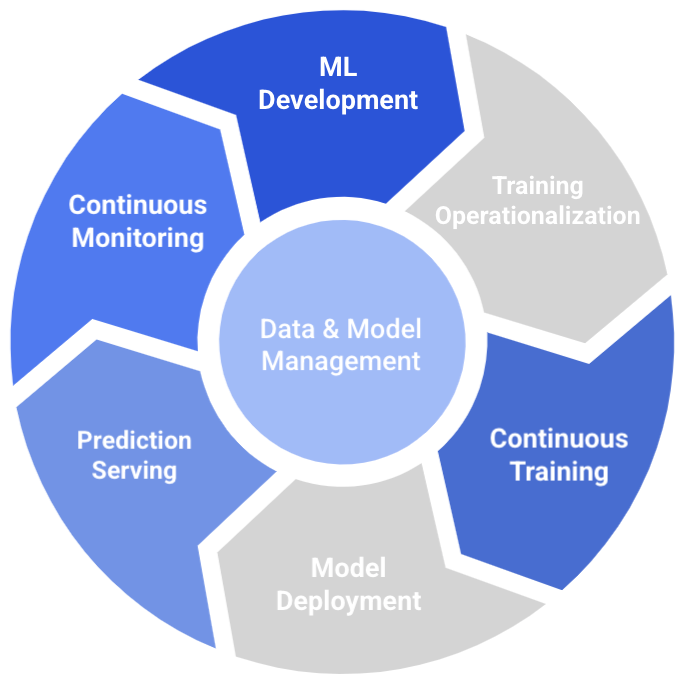This example implements the end-to-end MLOps process using Vertex AI platform and Smart Analytics technology capabilities. The example use Keras to implement the ML model, TFX to implement the training pipeline, and Model Builder SDK to interact with Vertex AI.
- Setting up MLOps environment on Google Cloud.
- Start your AI Notebook instance.
- Open the JupyterLab then open a new Terminal
- Clone the repository to your AI Notebook instance:
git clone https://github.com/GoogleCloudPlatform/mlops-with-vertex-ai.git cd mlops-with-vertex-ai - Install the required Python packages:
pip install tfx==1.2.0 --user pip install -r requirements.txt - Upgrade the
gcloudcomponents:sudo apt-get install google-cloud-sdk gcloud components update
The Chicago Taxi Trips dataset is one of public datasets hosted with BigQuery, which includes taxi trips from 2013 to the present, reported to the City of Chicago in its role as a regulatory agency. The task is to predict whether a given trip will result in a tip > 20%.
The 01-dataset-management notebook covers:
- Performing exploratory data analysis on the data in
BigQuery. - Creating
Vertex AIDataset resource using the Python SDK. - Generating the schema for the raw data using TensorFlow Data Validation.
We experiment with creating a Custom Model using 02-experimentation notebook, which covers:
- Preparing the data using
Dataflow. - Implementing a
Kerasclassification model. - Training the
Kerasmodel withVertex AIusing a pre-built container. - Upload the exported model from
Cloud StoragetoVertex AI. - Extract and visualize experiment parameters from Vertex AI Metadata.
We use Vertex TensorBoard and Vertex ML Metadata to track, visualize, and compare ML experiments.
In addition, the training steps are formalized by implementing a TFX pipeline. The 03-training-formalization notebook covers implementing and testing the pipeline components interactively.
The 04-pipeline-deployment notebook covers executing the CI/CD steps for the training pipeline deployment using Cloud Build. The CI/CD routine is defined in the pipeline-deployment.yaml file, and consists of the following steps:
- Clone the repository to the build environment.
- Run unit tests.
- Run a local e2e test of the
TFXpipeline. - Build the ML container image for pipeline steps.
- Compile the pipeline.
- Upload the pipeline to
Cloud Storage.
After testing, compiling, and uploading the pipeline definition to Cloud Storage, the pipeline is executed with respect to a trigger.
We use Cloud Functions and Cloud Pub/Sub as a triggering mechanism.
The Cloud Function listens to the Pub/Sub topic, and runs the training pipeline given a message sent to the Pub/Sub topic.
The Cloud Function is implemented in src/pipeline_triggering.
The 05-continuous-training notebook covers:
- Creating a Cloud
Pub/Subtopic. - Deploying a
Cloud Function. - Triggering the pipeline.
The end-to-end TFX training pipeline implementation is in the src/pipelines directory, which covers the following steps:
- Receive hyper-parameters using
hyperparam_gencustom python component. - Extract data from
BigQueryusingBigQueryExampleGencomponent. - Validate the raw data using
StatisticsGenandExampleValidatorcomponent. - Process the data using on
DataflowTransformcomponent. - Train a custom model with
Vertex AIusingTrainercomponent. - Evaluate and validate the custom model using
ModelEvaluatorcomponent. - Save the blessed to model registry location in
Cloud StorageusingPushercomponent. - Upload the model to
Vertex AIusingvertex_model_pushercustom python component.
The 06-model-deployment notebook covers executing the CI/CD steps for the model deployment using Cloud Build. The CI/CD routine is defined in build/model-deployment.yaml file, and consists of the following steps:
- Test model interface.
- Create an endpoint in
Vertex AI. - Deploy the model to the
endpoint. - Test the
Vertex AIendpoint.
We serve the deployed model for prediction. The 07-prediction-serving notebook covers:
- Use the
Vertex AIendpoint for online prediction. - Use the
Vertex AIuploaded model for batch prediction. - Run the batch prediction using
Vertex Pipelines.
After a model is deployed in for prediction serving, continuous monitoring is set up to ensure that the model continue to perform as expected. The 08-model-monitoring notebook covers configuring Vertex AI Model Monitoring for skew and drift detection:
- Set skew and drift threshold.
- Create a monitoring job for all the models under and endpoint.
- List the monitoring jobs.
- List artifacts produced by monitoring job.
- Pause and delete the monitoring job.
You can view the parameters and metrics logged by your experiments, as well as the artifacts and metadata stored by
your Vertex Pipelines in Cloud Console.
This is not an official Google product but sample code provided for an educational purpose.
Copyright 2021 Google LLC.
Licensed under the Apache License, Version 2.0 (the "License"); you may not use this file except in compliance with the License. You may obtain a copy of the License at: http://www.apache.org/licenses/LICENSE-2.0
Unless required by applicable law or agreed to in writing, software distributed under the License is distributed on an "AS IS" BASIS, WITHOUT WARRANTIES OR CONDITIONS OF ANY KIND, either express or implied. See the License for the specific language governing permissions and limitations under the License.
